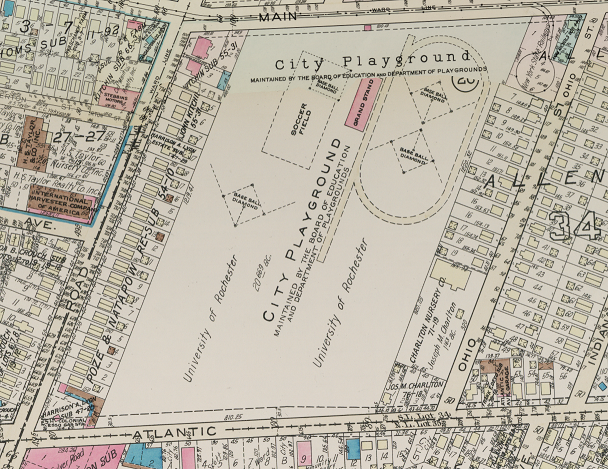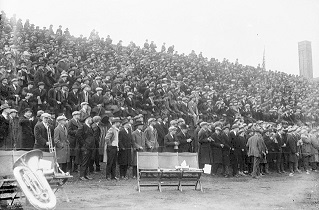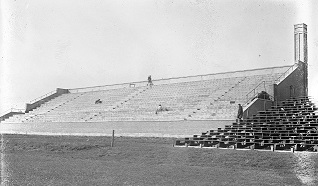
| Prince Street Campus | Cutler Road
Athletic Field |
 |
| Culver Road Athletic Field from 1935 City Plat Book |
| Pictures of the Culver Road Athletic Field Grandstand | |
 |
 |
The University bought a 22-acre site for an athletic field at Culver Road and Main Street in 1914. The site was bounded by Culver, Main, Atlantic and Ohio. A large concrete grandstand holding 1,700 was built with a football field and two baseball diamonds. A large celebration on November 10, 1917 dedicated the field, which was leased to Montgomery Ward & Co. in 1940 for a site, but was returned when the lease expired in 1950. After some heated public negotiations, the city bought the site in 1953 for a new East High School..
References
1914 "Athletic Field
For University Given Approval," Democrat and Chronicle,
November 14, 1914, Page 13
1915 Deed
from Edward P. Lyon to the University of Rochester, May 11, 1915,
$1,00, book 872, page 462
21.745 acres
1916 Annual
Catalogue of the University of Rochester
Pages 24-26: The New Athletic Field with plan
1917 "University
Will Be Honored by Citizens To-Day," Democrat and Chronicle,
November 10, 1917, Page 15.
Two views of grandstand on new University of Rochester Athletic Field.
1917 "Leading
Citizens United to Pay Respect to University," Democrat and
Chronicle, November 11, 1917, Page 31:
Opening of New Athletic Field Made Occasion for Public Demonstration in
Its Honor. Field Formally Given to Students.
1917 "Simple Ceremonies Mark Opening of Athletic Field," The Campus, November 15, 1917, Page 2.
1927 Rochester,
the making of a university, by Jesse Leonard Rosenberger, with
an introduction by President Rush Rhees.
Page 298-299: The athletic field, for which in 1914 the trustees
purchased about twenty-two acres of land fronting on Main Street East near
Culver Road, was partially developed in 1915 and, with a reinforced
concrete grand stand seating about seventeen hundred people, was completed
in 1917. It was formally opened or dedicated on November 10, 1917, which
for the occasion, and to show the interest of the citizens of Rochester in
the university, was made a civic holiday by a proclamation of the mayor of
the city. To begin with, there was a big parade from the downtown district
to the field. A squad of mounted police headed the formation, which
included the Rochester division of the New York Guard; the students and
alumni of the university and, in automobiles, the mayor of the city, the
president of the university, members of the board of trustees and of the
faculty, the president, officers, and members of the chamber of commerce,
members of the bar association and of various clubs and other
organizations. In his dedicatory address, President Rhees said: "This
field is not a playground for some of the students, but is the training
ground for all the students. We have obtained this field for the purpose
of enabling men to equip themselves for a more effective life. It is not
for the few, but for the many. It is dedicated to the cause of fuller
physical health for our students both while they are in college and
throughout their later lives."
1953 "UR,
City Agree on $650,000 For New East High School Site," Democrat
and Chronicle, November 28, 1953, Page 1.
Direct compromise breaks deadlock.
1953 Deed from the University of Rochester to the City of Rochester, 1953, book 2885, page 196
1977 History
of the University of Rochester, by Arthur J. May (on-line
version with footnotes)
Chapter 17, Sunshine and Shadow
Just as the Gallery was welcomed by men and women with artistic instincts
and the women's block by coeds, so the sports-minded rejoiced over the
acquisition of a new athletic field. In 1915 the corporation purchased a
tract of approximately twenty-two acres at the southeast corner of Main
Street and Culver Road, two miles distant from the campus, and occupied
today (1968) by the monumental East High School. Laid out there were a
football gridiron, encircled by an oval cinder track, two baseball
diamonds, and a concrete grandstand to accommodate 1,700 spectators;
beneath were dressing quarters for athletes, showers, and lockers. Plenty
of space remained for other types of games. A lofty iron fence surrounded
and protected the property.
With a maximum of fanfare, on November 10, 1917 the Culver Field was
formally opened. The event caught the imagination of the community.
Rochester's mayor proclaimed the occasion a civic holiday. A monster
parade of over a thousand alumni and undergraduates, the largest public
spectacle the University had ever mounted, marched by a circuitous route
from the center of the city to the Field, accompanied by mounted police, a
detachment of National Guards, and three bands. More sedately, "Prexy,"
trustees, professors, municipal dignitaries, and clubmen rode in a
spectacular procession of some 500 automobiles. American flags, emblems of
the Entente nations, and banners of sister colleges flapped jauntily in
the breeze. U. of R. fans were distinguishable by yellow armbands and
their ladies by yellow chrysanthemums; military uniforms were generously
sprinkled in the huge crowd of spectators. Once speeches of dedication and
gratitude had been delivered, the U. of R. football team did battle with
Wesleyan--the colleges of the Fauver brothers. The contest was charged
with high emotion, and, notwithstanding the disappointing outcome (the
yeomen from Middletown, Connecticut, carried home a victory), the game was
replete with thrilling moments. During the summer months the general
public was permitted to use the Culver playing fields.
Chapter 33, The First Century Ends
The large University athletic field at Culver Road and Main Street, scene
of sporting events from 1917 until the opening of the River Campus, which
had been leased in 1940 to Montgomery Ward & Company for a store,
returned to the University when the lease was terminated (1950) by mutual
agreement. The trustees considered selling the land for a large housing
development, but no decision was actually reached at the time.
Chapter 35, Reunion of the Colleges
On the eastern edge of Rochester, the twenty-acre University Field along
Culver Road was finally disposed of. For years the University authorities
envisaged a lucrative income-earning housing or commercial development on
the tract, but in 1951 the Rochester Board of Education indicated that it
would like the area for anew high school. While the University was willing
to sell, the price set by its appraiser was more than double the valuation
proposed by a School Board appraiser. Controversy over the price was
freely ventilated in the Rochester press and unquestionably hurt the
community drive for the University Development Fund of 1953. As the end
result of intricate bargaining, a compromise figure of $650,000 was agreed
upon, the University acquiescing in the public interest and to counteract
accusations of greediness.
© 2021 Morris A. Pierce